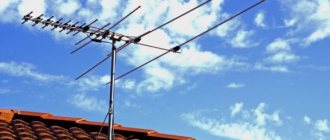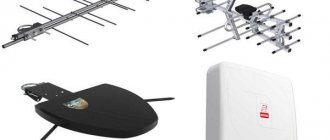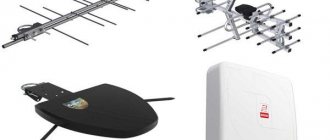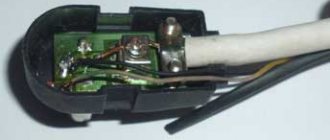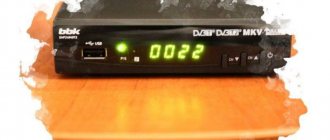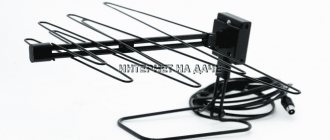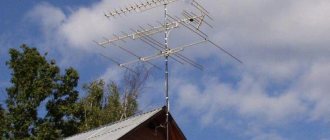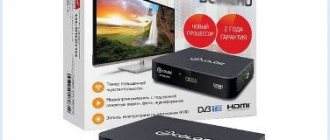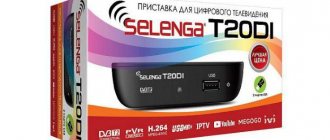An indoor TV antenna for receiving DVB-T2 television is always a compromise between appearance and quality of the received signal. It's more likely not even about quality, but in general about the ability to watch digital TV using an internal catcher.
Indoor antenna TV JET 5340 (UHF)
Indoor antennas are distinguished by a laconic appearance and a minimum of installation effort, but in order for them to be useful, several simultaneous conditions must be met. Correct operation of the device indoors depends on:
- distance to the nearest transmitter;
- presence and type of built-in amplifier;
- type and thickness of the building walls;
- the size of the windows, their location in relation to the TV tower;
- type of window glass (technology for their manufacture);
- quantity, dimensions, arrangement of furniture in the room.
Stable indoor television reception can be disrupted by changes in any of these factors or even by the normal use of household appliances due to their close proximity (direct contact) to the radio wave receiver.
So, you know the parameters, as well as the specifics of the place where you expect to catch the TV signal (cable length, number of consumers) and do you want to have it from a simple indoor antenna? All you have to do is get the right model.
Kinds
The transition to digital broadcasting in Russia is at its peak, but its pace is somewhat exaggerated. Many families still watch, or are forced to watch, programs in the usual analogue quality. In places where there are television towers or repeaters, indoor TV antennas are not new. But is your old indoor antenna suitable for a digital signal? To receive digital broadcasting without installing an outdoor signal receiver, your indoor receiving device needs to catch decimeter waves or be broadband.
All-wave indoor antenna MV-UHF
There is an opinion that all-wave broadband catchers for “digital” are useless. In fact, devices of this type often demonstrate the opposite, because the problem lies not in their design itself (the main lobe of their radiation pattern is almost round), but much more often in the amplifiers with which they are equipped - without shielding, with a high noise level.
In some cases, the wide range of radio waves captured by an indoor broadband receiver can have a negative effect: the unwanted signals it receives will “clog” the DVB-T2 signal.
All-wave (MF-UHF) indoor antenna viva
A high-quality all-wave receiver has a chance to show itself in dense urban areas. Reflected television signals often occur within neighborhoods, and correct orientation of the directional model can be difficult.
The all-wave indoor television antenna is designed to receive all terrestrial television programs, both for analogue and digital broadcasting.
UHF indoor antenna
“Digital” broadcasts are carried out with radio wavelengths from 10 cm to 100 cm. A device whose instructions indicate that it is intended for the UHF range can be guaranteed to receive digital channels.
UHF (UHF) antenna
External devices of this type have an elongated design with a large number of crossbars (directors), due to which the signal reaching the vibrator is noticeably amplified. The radiation pattern of this receiving device has a narrow and elongated main lobe.
You may be interested in: Modern digital television
The indoor UHF antenna, being a compact device, nevertheless has an identical structure, but with fewer crossbars, which can be hidden under a plastic shell in order to give the structure an original look.
Active or passive
All wave receivers can be divided into several groups: by type of design, method and location of installation, and other parameters. An indoor antenna for digital television is always a choice dilemma: should it be active or passive? A passive indoor antenna is one that does not have a built-in signal amplifier. According to the majority, this is the type of device you should choose for your home. This approach is based on the judgment that the length of the cable to the TV is short, only a few meters, so the device does not need an amplifier, because the signal in this section is not distorted. An active indoor antenna, that is, with a built-in amplifier, helps out when it itself is obviously low-power, and its installation is supposed to be at a considerable distance from the digital decoder. The cable will inevitably be subject to signal loss.
Television antennas with an amplifier have their supporters, but it is worth recognizing: the signal is received by the catcher itself, and not by its amplifier. How it copes with this task largely depends on its design, otherwise manufacturers would not be struggling with the best passive models, but would simply equip them with amplifiers, entrusting all the work associated with reception to them.
Amplifiers for indoor television antennas compensate for losses that occur on the way to the television receiver - receiver or TV. Each coaxial cable has a so-called attenuation coefficient, i.e., as the length of the cable increases, the level of the received signal decreases. If this distance is only a few meters, and the signal is obviously strong, then passive indoor antennas are quite suitable for watching digital television.
The situation is the opposite: there is a large house in a populated area with a good digital signal, one indoor radio wave receiver, cable splitters for several rooms, sockets and a wire length exceeding, for example, 40 meters. Each element - a splitter, a socket, and especially a long cable - causes a decrease in the signal. This is where it makes sense to use an active TV signal catcher.
When choosing between active and passive designs, use common sense: do not buy an expensive signal receiver with a powerful amplifier if you live five kilometers from a TV tower. The signal level of the active device may be so strong that it “overloads” the tuner or it produces strong noise and interference. As for the amplifier, it is a device that consumes electricity. Its consumption is small, but it is there. The active model only works when the amplifier is connected to the network. A device receiving waves with the amplifier turned off does not become passive; it cannot receive a signal at all.
Poor quality of the received signal and general features of operating an indoor antenna in the country
Be careful: TV antennas are susceptible to lightning current - do not use your TV during a thunderstorm. When temporarily living in a suburban area, one way or another you have to turn on the TV to keep abreast of city events. But in some areas, the quality of the digital image leaves much to be desired, and it makes no sense to install an outdoor antenna. Let's discuss how to enhance radio wave reception with a standard indoor antenna.
- Try changing the location of your antenna or simply turning it in the opposite direction. Sometimes the TV signal comes to you from a different tower, and not from the local one.
- Search for channels on your TV manually after these steps have been completed.
- Connect a special amplifier to the cable of the TV receiver (you can buy them on the radio market).
- Remove possible interfering objects: even a simple metal figurine can cause a poor reception signal.
- Check the integrity of the cable - very often it bends exactly at the junction with the plug.
To construct an antenna or amplifier with your own hands, you need to know exactly the working circuit of the device. If your antenna is operational, then the methods listed above can solve the problem of low-quality images. Otherwise, try changing the room receiver - the internal structure may have failed. Remember that an indoor antenna should only be used for its intended purpose. If this is a TV receiver, then you should not try to connect it to a radio or other devices. In the apartment they manage to place the indoor antenna even on the roof of the balcony - it is not yet clear whether there is any result. Avoid exposing the device to water and dust. Very soon this may affect the performance of the antenna.
You should not unknowingly use any amplifier for an indoor antenna: there are models with built-in equipment, and there are those that simply do not support such a system. You can learn more about this feature in the manual for your repeater. If you use a digital set-top box for digital TV, then be sure to purchase a power supply for the antenna.
Selection of recommended television antennas for DVB-T2
It is difficult to answer the question: will it show digital television with an indoor antenna without purchasing it and trying it in action in local conditions. You need to understand whether you need a powerful indoor DVB-T2 antenna with an amplifier or whether the signal in your home is so strong that a passive catcher will do.
REMO BAS-5320-USB Inter 2.0
The purchased device, even if it is internal, must have a radiation pattern that is at least slightly different from the geometric circle.
You may be interested in: How to connect a digital set-top box to your TV
Wavelength receivers that have a chance of success have one thing in common: they are highly directional and are good at picking up the signal from the direction they are looking, while trying to ignore extraneous signals. A narrow beam model is the first step towards good digital television reception in the room.
REMO BAS-5310USB HORIZON
By this time, the domestic buyer has already formed a certain rating of models in the “appearance-cost-functionality” ratio, which will help you choose an indoor antenna for your TV.
The best indoor antennas with amplifier for TV:
- REMO BAS-5320-USB Inter 2.0 is an all-wave indoor active model that reliably picks up digital and analog signals. The amplifier is powered by an adapter or via USB. The device has an innovative design, its body is durable and ergonomic;
- REMO BAS-5310USB HORIZON - a device of this brand is designed for areas with very good reception. It has a minimalistic appearance, due to which it will successfully fit into a single composition with any TV and tuner, and can be attached directly to the TV. Type – active;
- DENN DAA210 - this active internal design combines many things: compactness, an active method of receiving radio and terrestrial television signals (T2 and analogue), built-in noise reduction device, affordable cost;
- VIVANCO is a family of active and passive models for the home, which has proven itself well in digital and analogue reception at various frequencies.
Recently, panel antennas have been gaining popularity. They have a compact design housed in a flat body. For a relatively low price, you get a universal receiving device: it is suitable for use both outdoors and indoors. Models of this design provide good TV signal reception.
Review of popular models
Below I will give some examples of good receivers from different price ranges. They are suitable for any device - the antenna for a smart set-top box and a digital tuner are no different. Only the features described above are important. And, as always, these are just examples to give you an idea of the range of prices and types. You can find the right option for yourself, focusing on your nuances.
Ritmix RTA-001
This is the simplest antenna that is suitable where there is a good signal. This model is not equipped with a stand, but many TVs have a recess for installing receivers of this type.
pros
- price;
- simplicity.;
Minuses
- no stand;
- only for areas with good signal;
- design.;
Price:
about 600 rubles
USB Horizon BAS-5310
USB Horizon BAS-5310 – broadband active indoor receiver. Its design will decorate and not spoil the interior. Power can be supplied through the USB output of a digital set-top box or TV.
pros
- active;
- broadband;
- USB for power;
- design.;
Minuses
- the usual disadvantages of active broadband devices;
- the cost is comparable to external ones.;
Price:
about 1250 rubles
BAS X11102 MAXI-DX
BAS X11102 MAXI-DX is an external active receiver capable of picking up a signal over a long distance. If installed correctly, it will help you watch digital TV both in the country and in the village.
pros
- external and active;
- reliable: high-quality aluminum;
- wear-resistant;
- built-in GSM and LTE noise filters;
Minuses
- requires installation;
- price.;
Price:
about 3000 rubles
How to connect a TV antenna
Most indoor TV antenna models come with a cable and antenna connector. Developers design their products more for ideal reception conditions, so the cable of factory models has a limited length (up to 1.5 m) and is not of the best quality. In the case of digital reception, you are unlikely to be able to create a spectacular picture: a TV with a compact antenna next to it or on it. If your TV is not installed near a window where it would be advisable to place the TV signal receiver so that it can better pick up the “digital” signal, then you will have to add a cable. This plus several meters of cable extension and one additional connection, and, as a result, some signal attenuation.
How to connect an indoor antenna to a TV
For the lucky ones whose TV can independently receive T2 television, just insert the plug into the TV socket. What and how to configure in the menu? You need to select “digital signal” in the TV menu. Indoor antennas with an amplifier must be connected to the electrical network; do not forget to connect the adapter to the outlet before starting “Autosearch”.
How to connect to a set-top box
If you don’t want to change your TV that’s not too new, but works well, then don’t. Buy an additional digital receiver for your TV and connect it correctly.
Carefully unpack the TV antenna and place it on a window that faces the TV tower. Before this, you inserted the plug into the corresponding socket on the TV. Now your task is to insert it not into the TV, but into a brand new, recently purchased digital terrestrial tuner. The processed television signal from the audio-video output of the tuner is fed to the audio-video output of the T2 receiver. If you have a passive indoor antenna, then the connection ends there. You can proceed to searching and setting up TV channels.
You may be interested in: Connect a monitor to a digital TV set-top box
When connecting a TV antenna with an amplifier, do not forget to connect the amplifier adapter to the power supply. This must be done after all cable connections. A voltage of 5 volts can be supplied to the amplifying microcircuit directly from the receiver and no additional wire is needed. Afterwards you need to activate the power directly from the set-top box menu. Go to the menu, go to the settings section and find the “5V power” item, select “ON”, and click “OK”.
TV and digital TV set-top box
Our Blonde talked about whether it is possible to configure an analog TV to watch digital TV here.
Before you figure out what kind of antenna you need for digital TV, you need to resolve the issue with your TV. Devices that went into production and sale after 2012 usually have a built-in digital receiver. In this case, connection is not a problem. It is enough to select the required item in the settings, which switches the signal reception.
If the equipment is a little older, but there is no desire to replace it, a special DVB T2 set-top box comes to the rescue. There are many consoles in stores today that differ in additional functions and design. But the main task is the same - decoding a digital signal into an analog one.
Before choosing a set-top box, you need to familiarize yourself with the antenna sockets of the TV. If necessary, connecting cords must be purchased with the receiver.
The digital set-top box is equipped with three sockets - red, white, yellow. The set includes tulip wires. Not all older TVs are also equipped with three outputs. There are models with two sockets or a SCART output.
If the equipment has only two sockets, you will need to make some efforts in order to select a combination in which the set-top box will function. Don’t be alarmed if one of the wires remains “out of use.”
Borodach spoke in detail about how to switch to digital TV. Read here.
TV antenna location
Indoor antenna location
In order for an indoor wave receiver to properly perform its function, several conditions must be met. An indoor TV antenna for indoor use is a good solution only for those whose distance from the TV tower to their home is no more than 20 kilometers. Compared to external antennas, indoor antennas are a relatively weak device. In order for the reception to be acceptable, you need to carefully search for potential installation locations in your home where it will reliably receive the signal.
First of all, find the location of the nearest transmitter - this information can be obtained by searching the CETV coverage map. Next, place the antenna in the direction of the nearest repeater. Optimal reception quality is usually achieved near a window, at the maximum height. The internal structure is more vulnerable than others to obstructions: tall buildings, trees or elevations, so in a private house it would be justified to place it as high as possible, for example, in the attic.
Many household appliances can complicate the operation of an indoor TV channel catcher. Any other radio wave receivers are not the best neighbors for it. Even protective decorative grilles on windows can create interference, reducing the quality of the received television signal.
Basic selection criteria
When buying an antenna, you need to take into account the brand, reviews from owners who have already tested the device.
- Cost is not considered a key factor, however, cheap models from unknown manufacturers are a pig in a poke. Expensive elements in the country are appropriate if the signal is very weak.
- The next criterion is reliability. The device is purchased for several years, so it must be resistant to atmospheric influences. Steel options are stronger and are not afraid of icing, while aluminum counterparts are lighter and do not rust. Do not forget about the reliability of the fastenings. The plastic compartment where the amplifier is placed must be sealed.
- The final choice is made after communicating with neighbors in the country, store consultants or browsing relevant online forums.
Gain
Gain is an extremely useful and important parameter for assessing the performance of a trapping structure. This is not the gain of the amplifier, but the antenna’s own gain when precisely aimed at the transmitter.
To enhance the indoor model of the receiver, it can be retrofitted with a device to increase its performance. Many models that the radio market offers come with an amplifier already installed, but it can also be purchased separately for the indoor antenna that you already have.
Installing an amplifier that is too powerful paradoxically worsens reception. The gain will affect not only the useful signal, but also any interference in the reception area. The optimal solution is to purchase an amplifier that has a voltage regulator on the power source. This way you can independently control and delicately adjust the signal amplification level.
However, generally accepted practice suggests that for DVB-T2 the use of amplifiers in combination with indoor wave receivers is best avoided. Similar to choosing an antenna, it all depends on the power and distance to the transmitter. For towers located at a distance of up to 30 km or more, especially if their output signal power is low, amplification will most likely be required. Often, imperfect conditions on the ground do not contribute to good reception (dense buildings, forest belts) and then the solution may be to receive a reflected signal. In this case, an amplifier can really save the situation, increasing the chances of successful reception.
